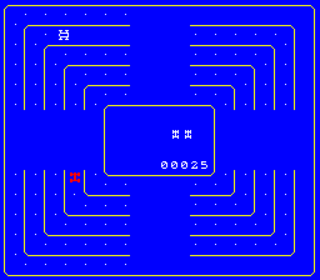Overview

Head On, also known as Head-On or HeadOn, is a top-down driving maze game developed by Gremlin and released by Sega for arcades in Japan on April 1979, with a release by Gremlin themselves (as Gremlin/Sega) on June 1979.
In Head On, players control a car moving non-stop around a multi-lane looping track as they try to collect all the dots on the board while avoiding collision with one or more red cars that are trying to ram them head-on. As the lanes are walled, they can only move between lanes at certain areas on the track, and can accelerate to quickly move towards those areas. Players receive bonus points based on how fast they clear the board, and sometimes the red cars double the points on the dots they cross.
The game received two versions: one made for horizontal-oriented monitors (made ideally for sitdown "cocktail" arcade cabinets) and one made for vertical-oriented monitors (made ideally for upright arcade cabinets). Later versions also added two-player alternate play.
Along with numerous clones, both official (such as Head On N) and unofficial, the game received two sequels (Head On 2 and Car Hunt) and a licensed 1990 port for the Game Boy (which was developed by Graphic Research, released by Tecmo, and is known in North America as Power Racer). It was also ported to the Sega Saturn, as part of the Japanese-exclusive compilation Sega Ages Memorial Selection Vol. 1. A prototype for a successor to the game, known as Head On Channel, was later found and preserved.
The game also received a low-quality demake, known as Dottori Kun, that was released with Sega's arcade cabinets in the 1990's as a "throwaway board" to skirt around a Japanese law prohibiting the sale of arcade cabinets without any game hardware included.
Log in to comment